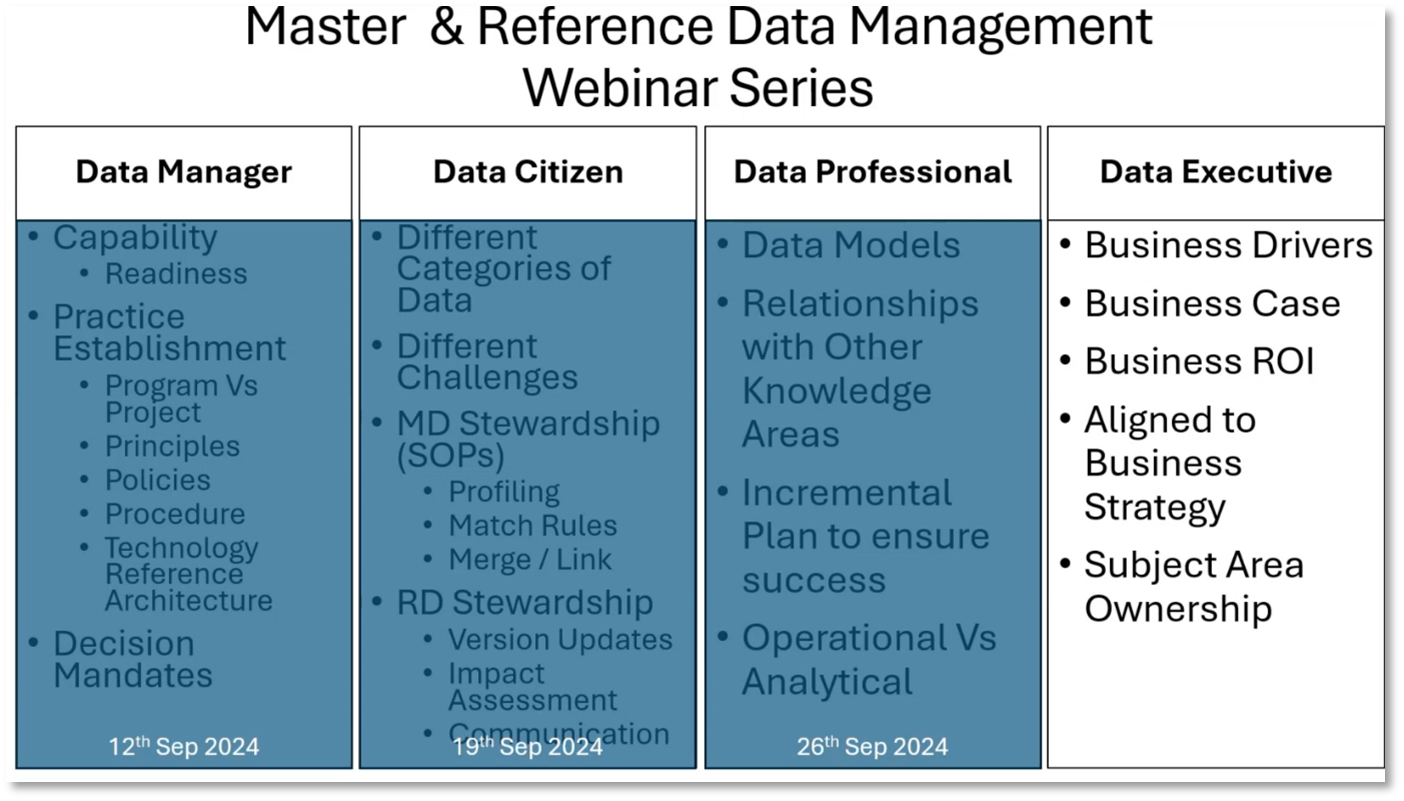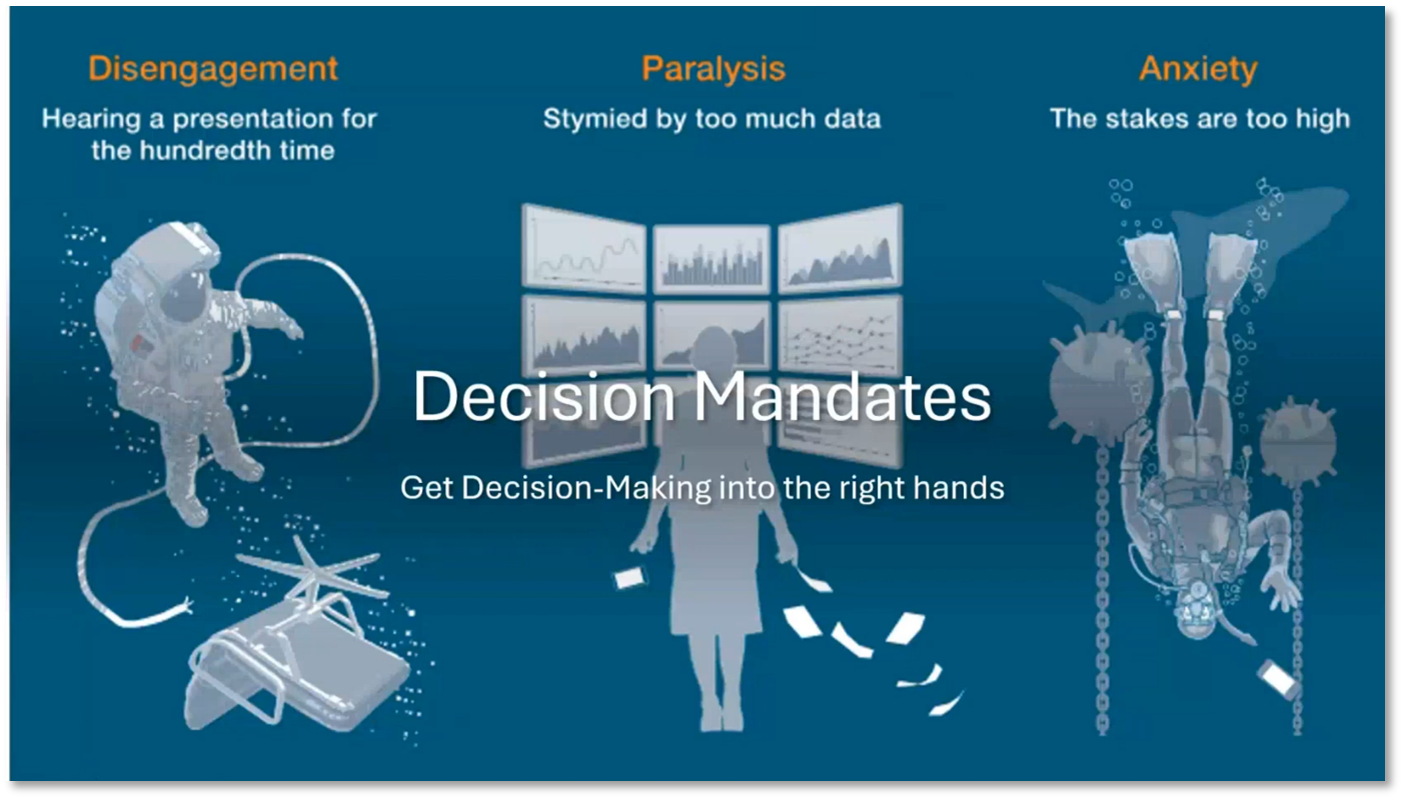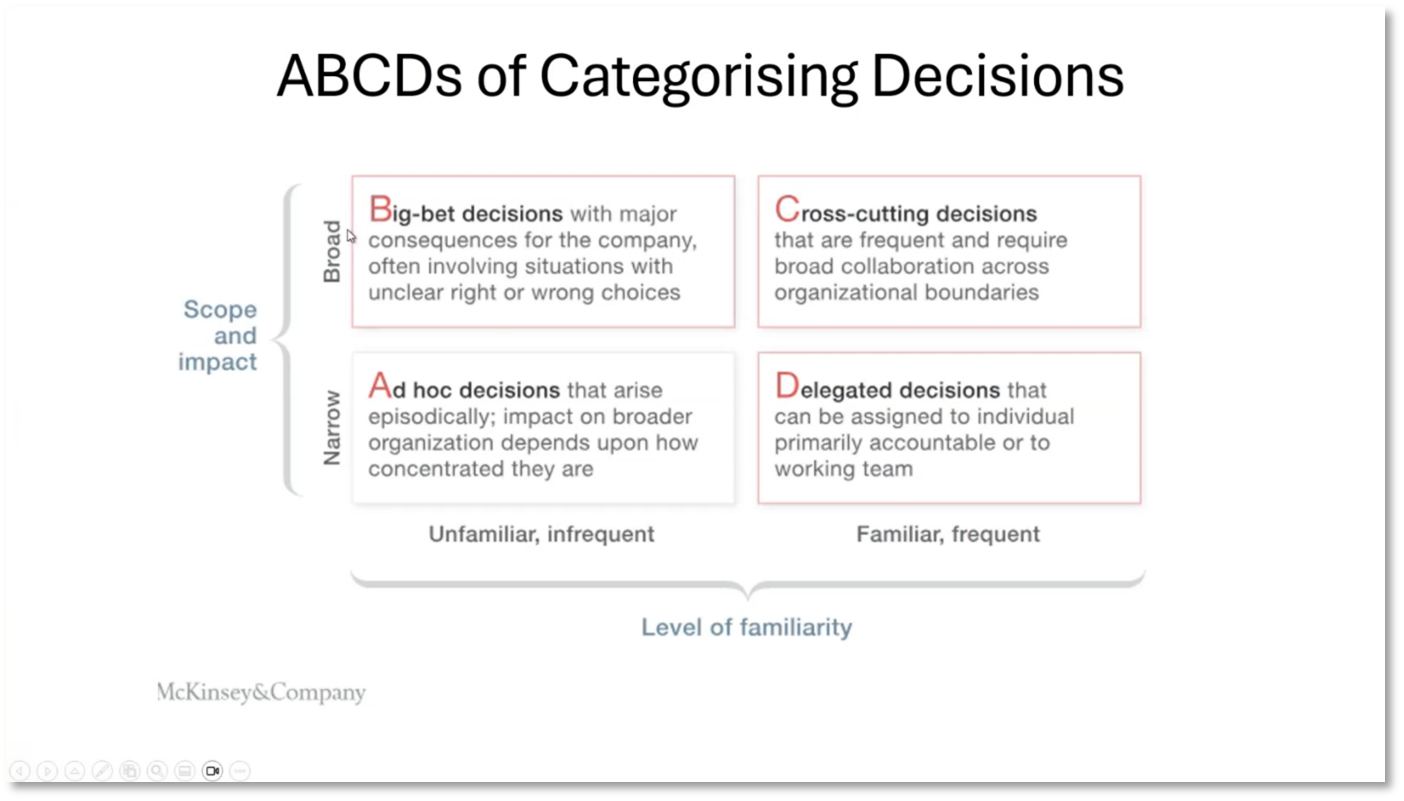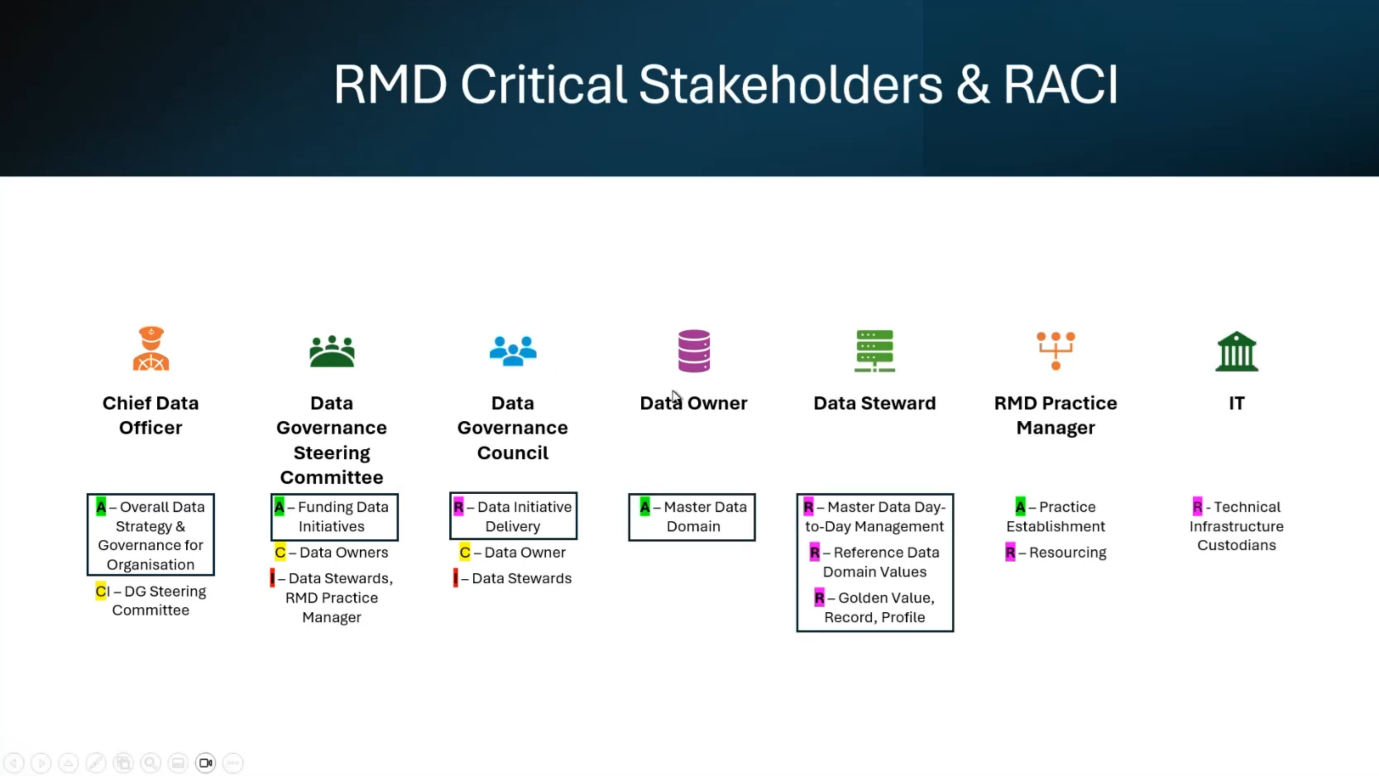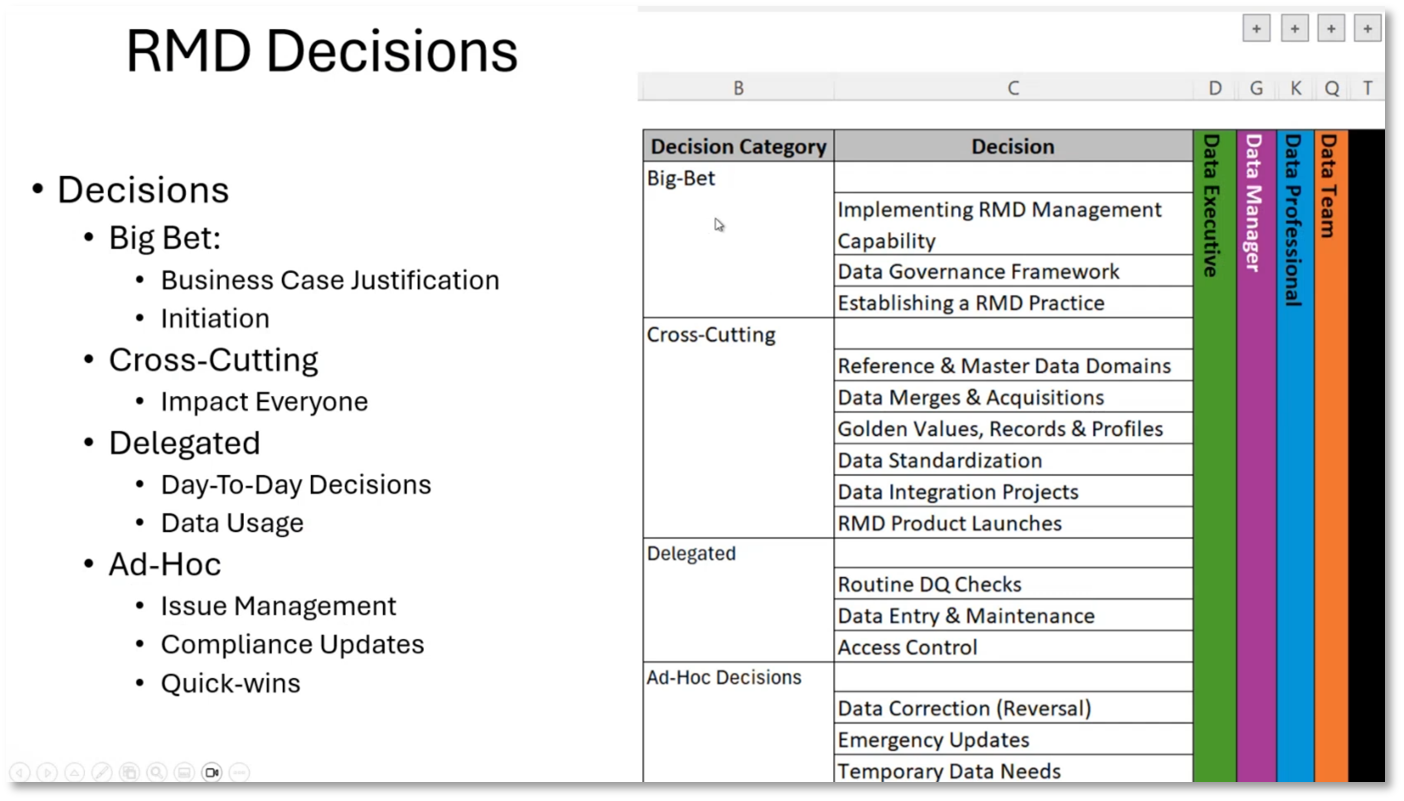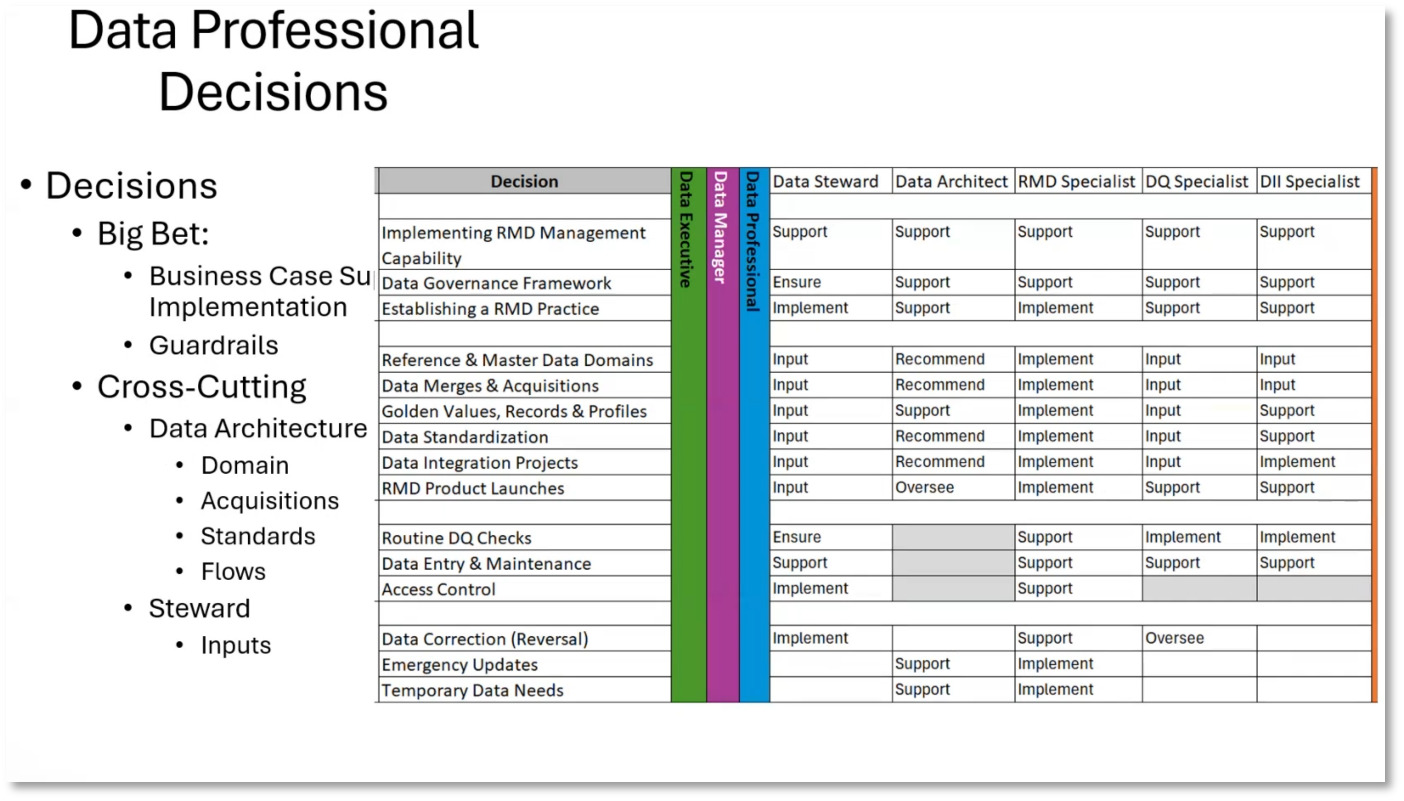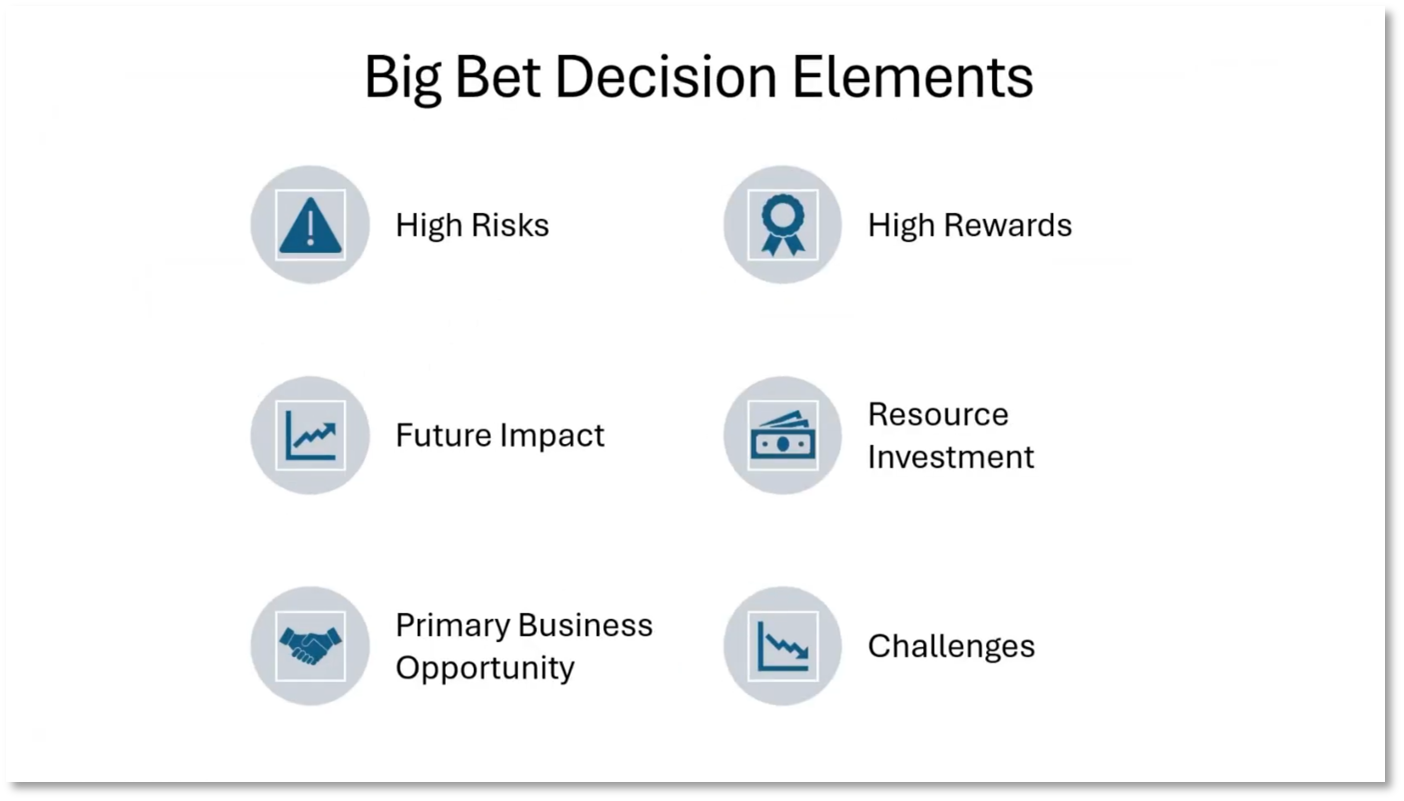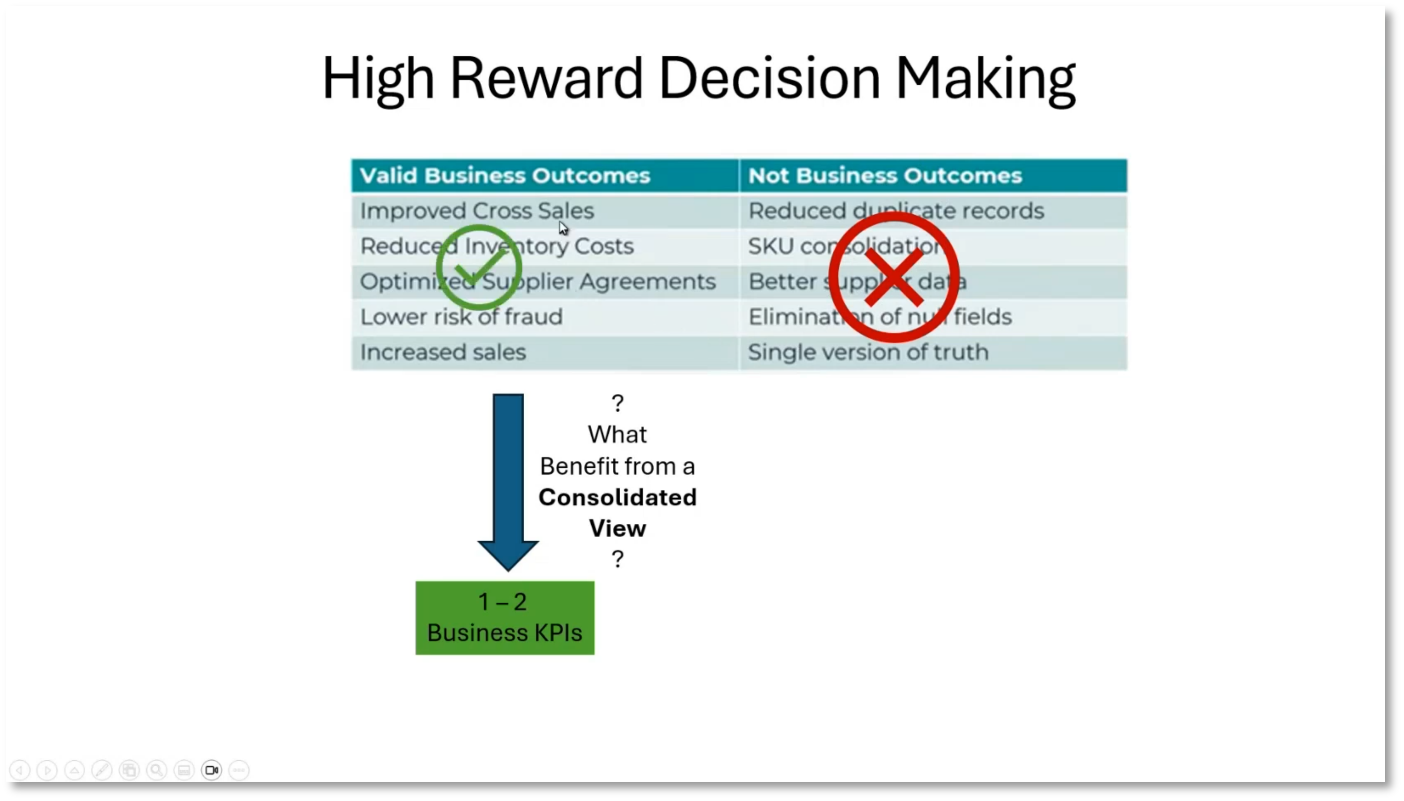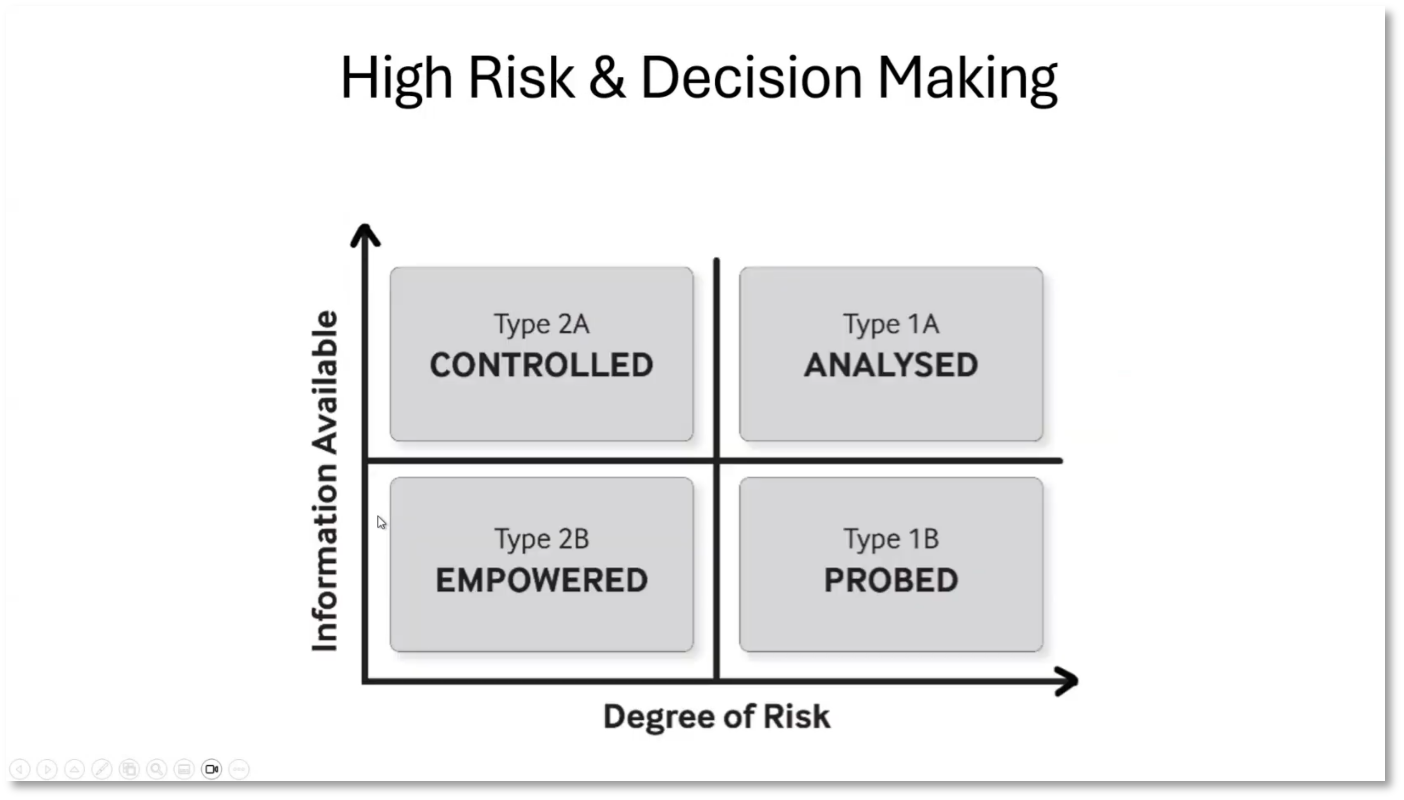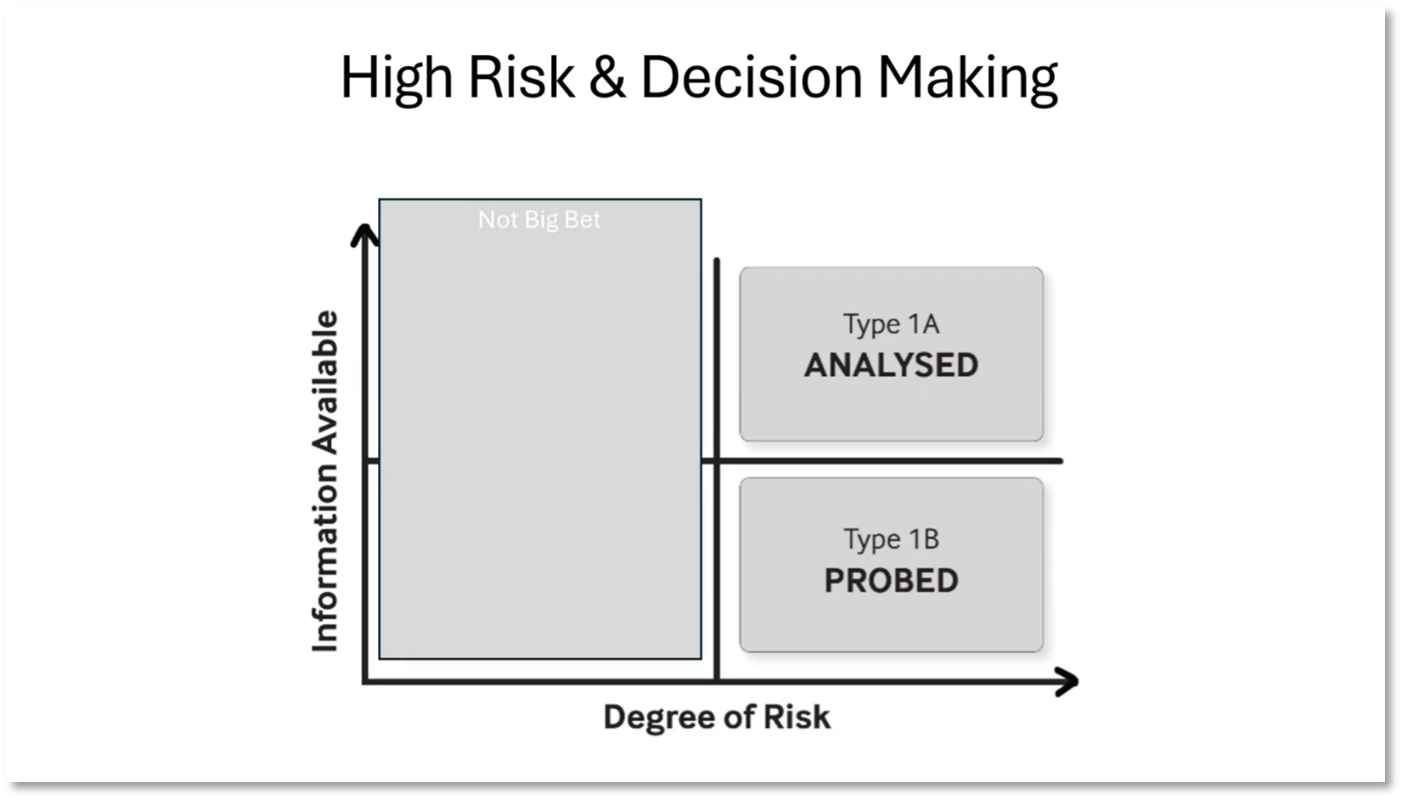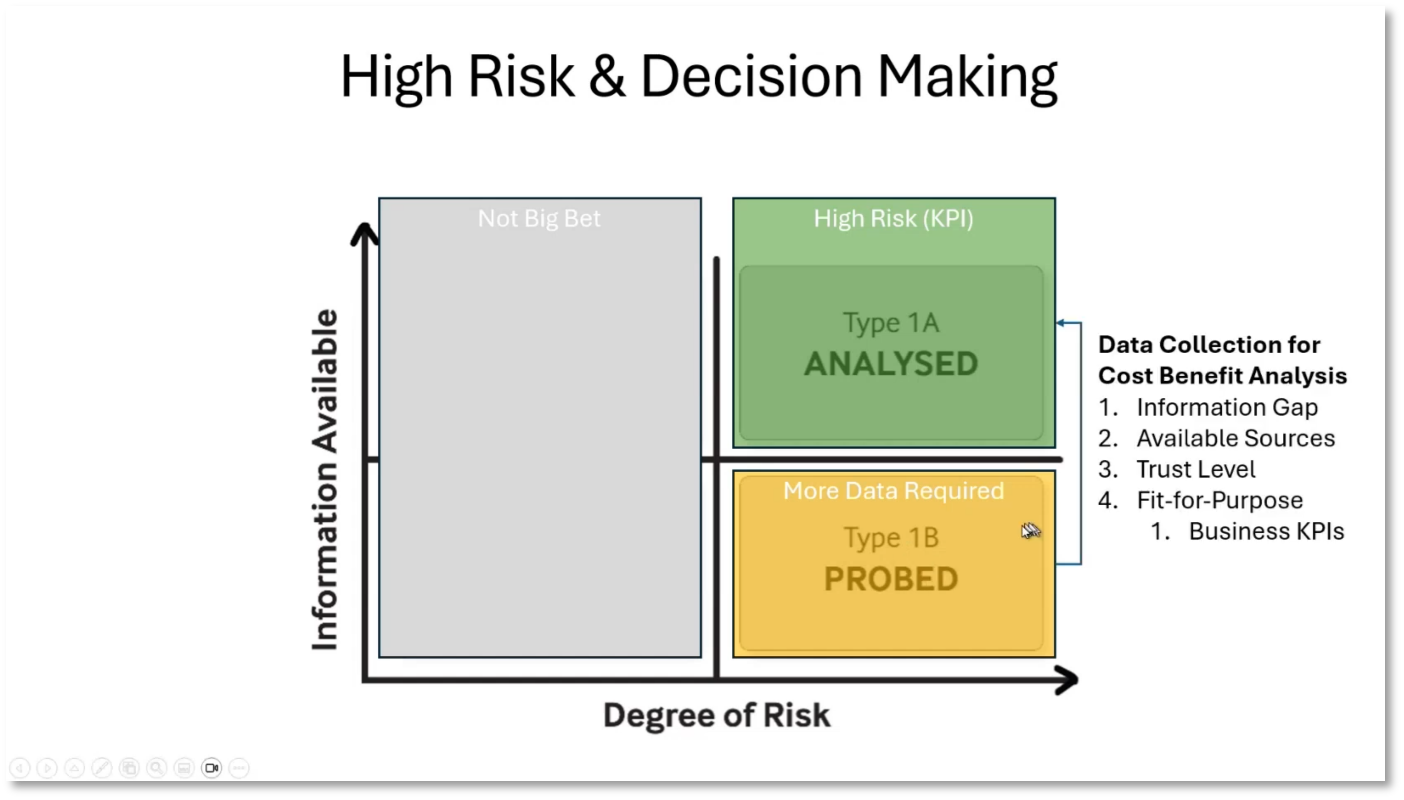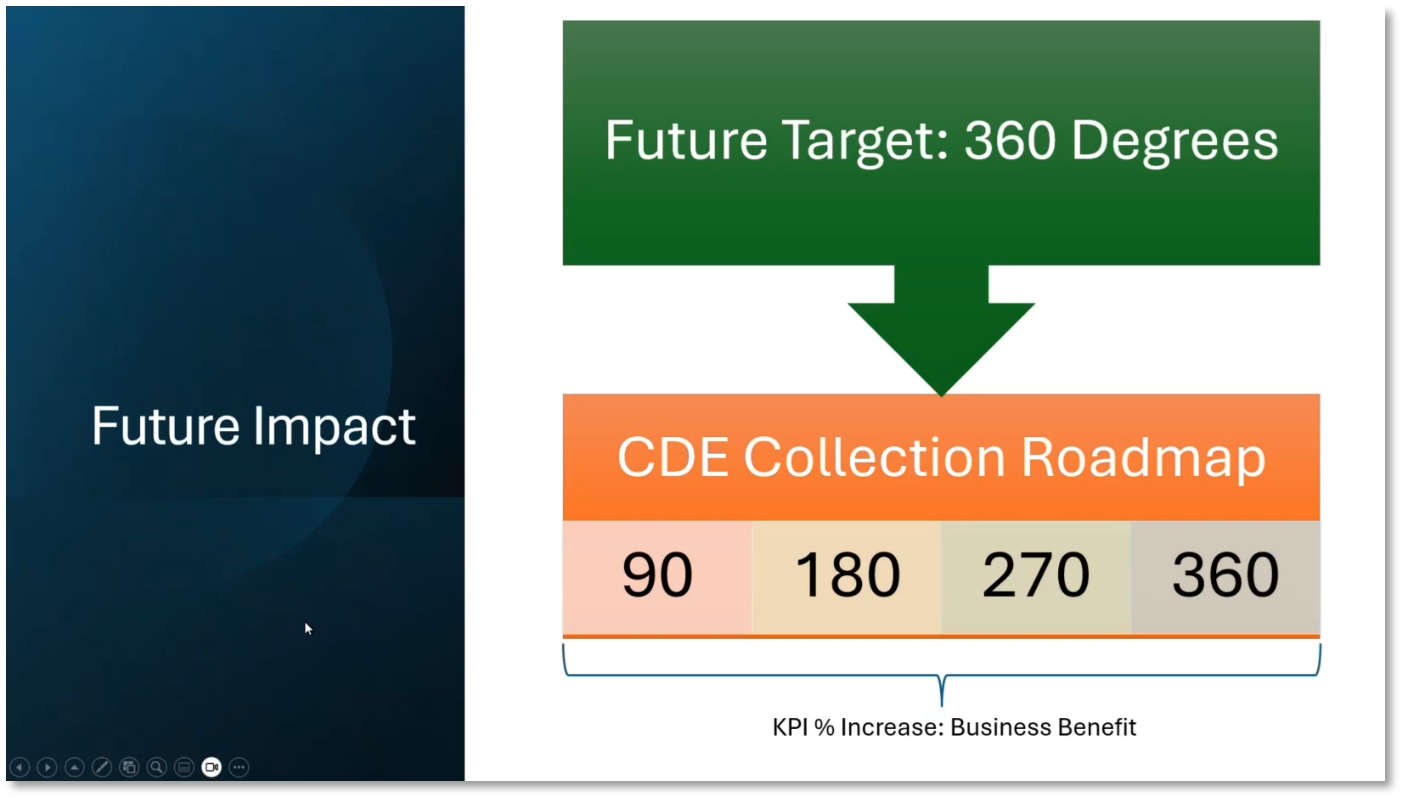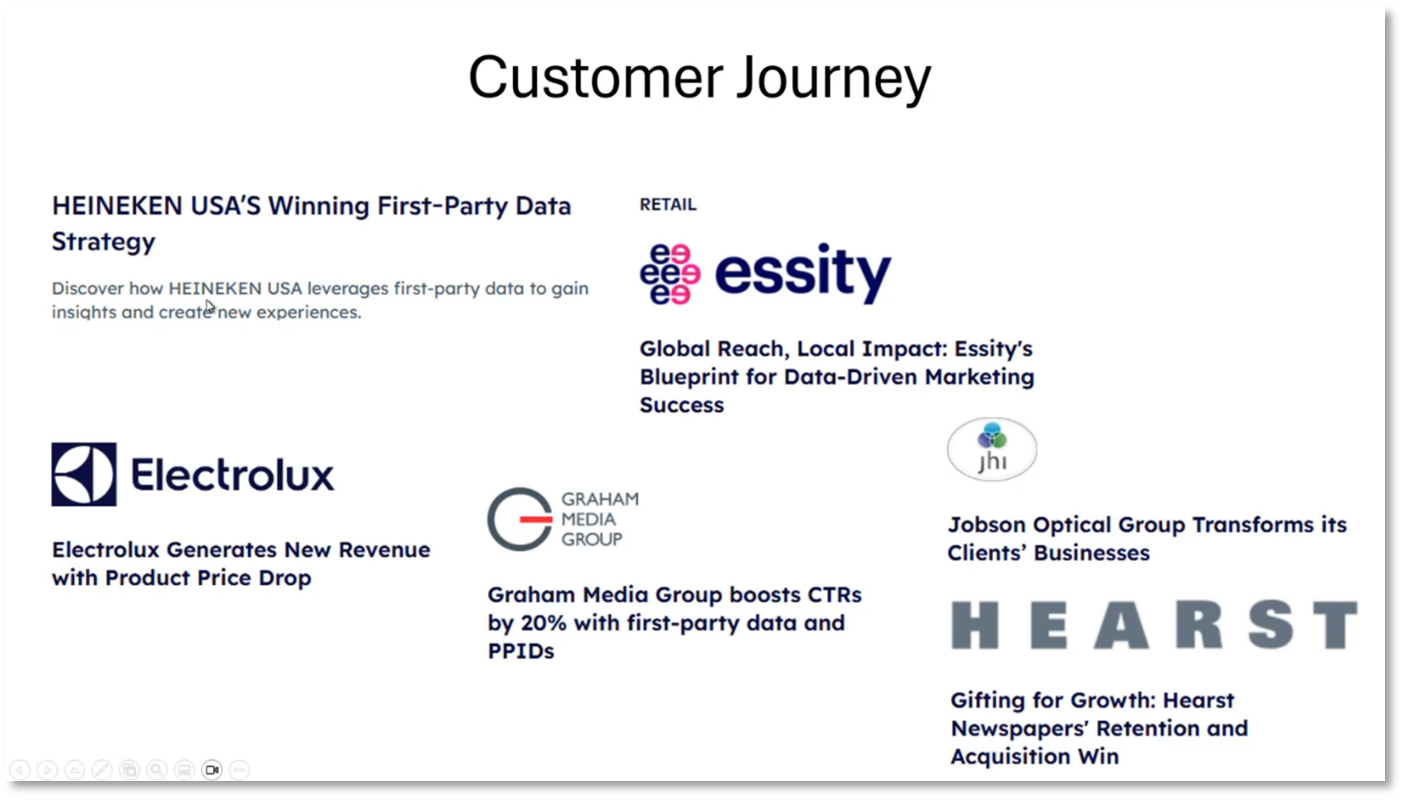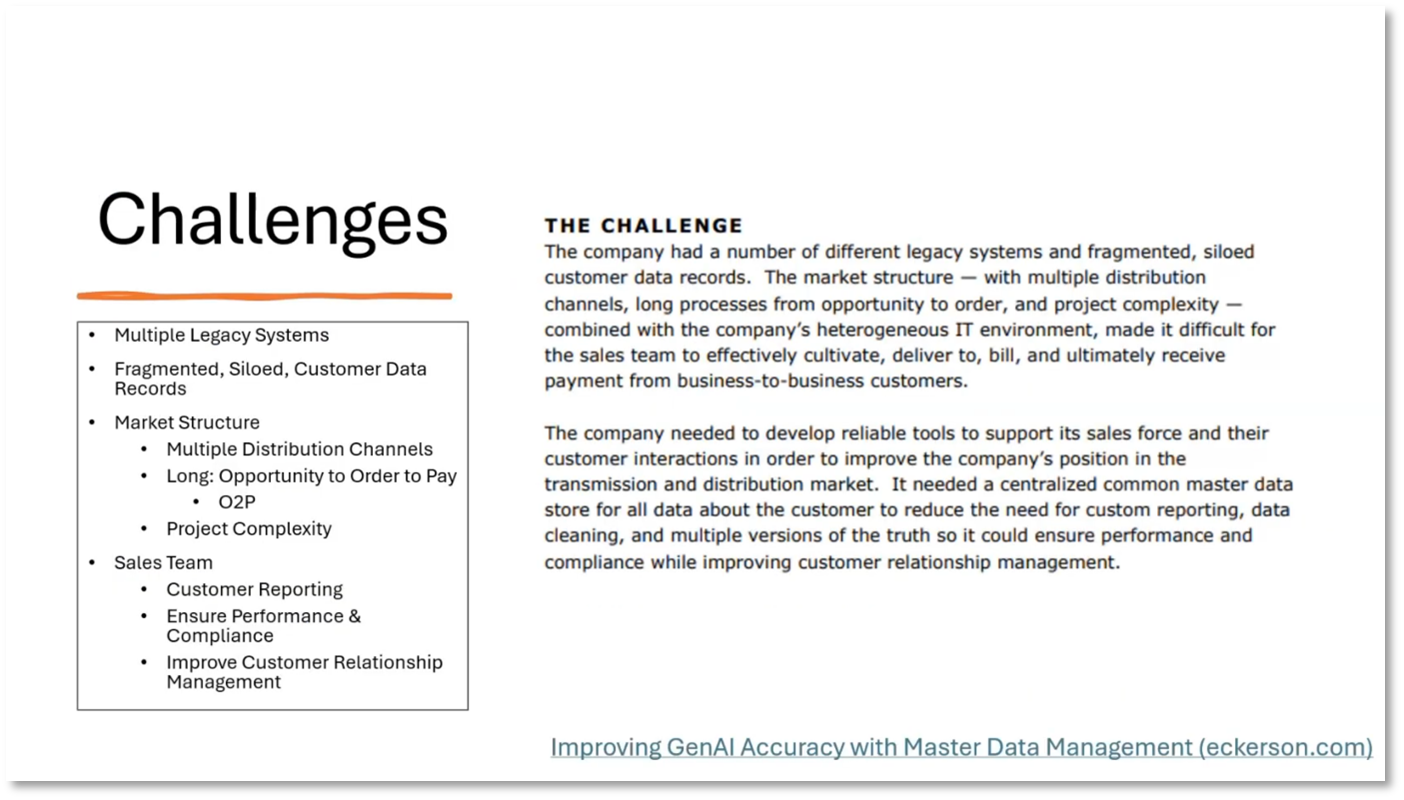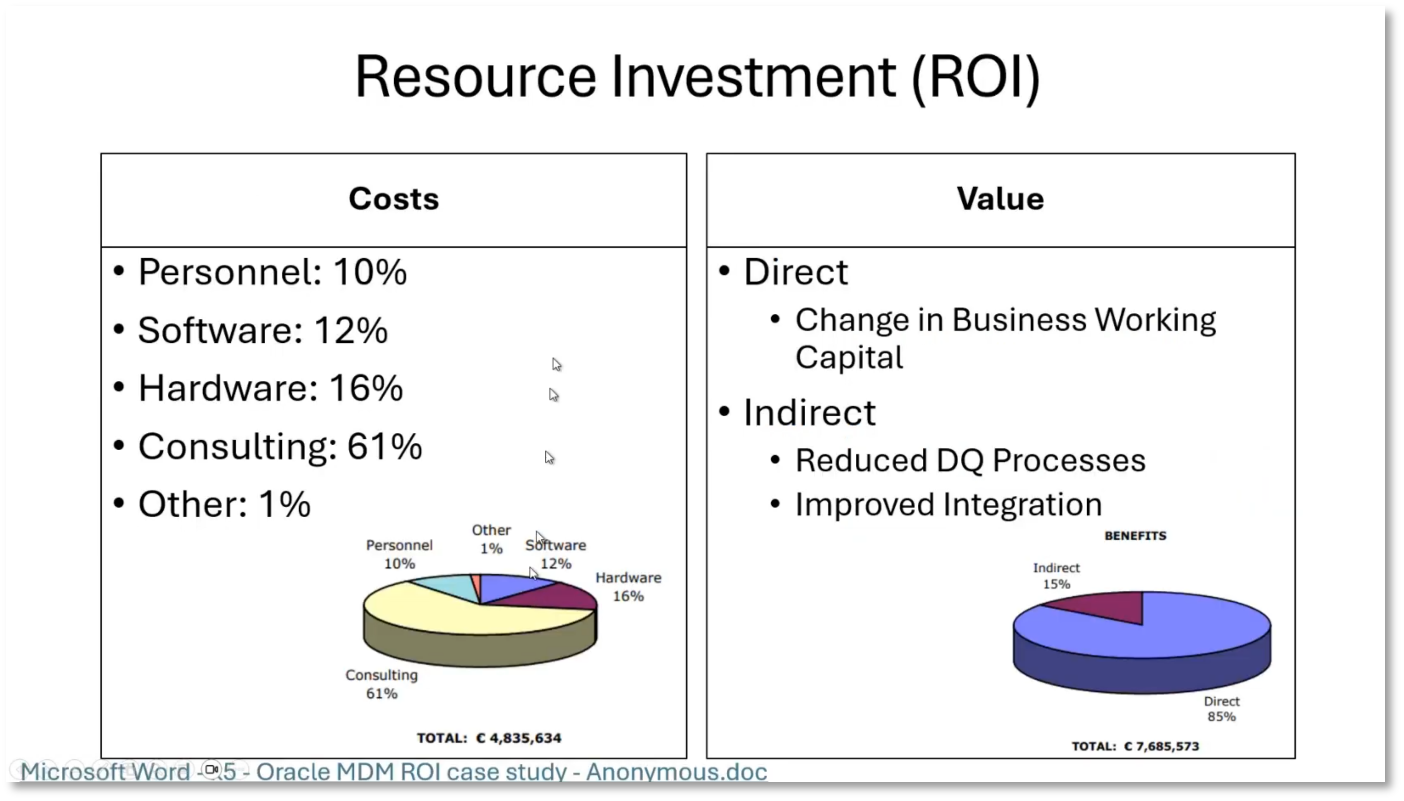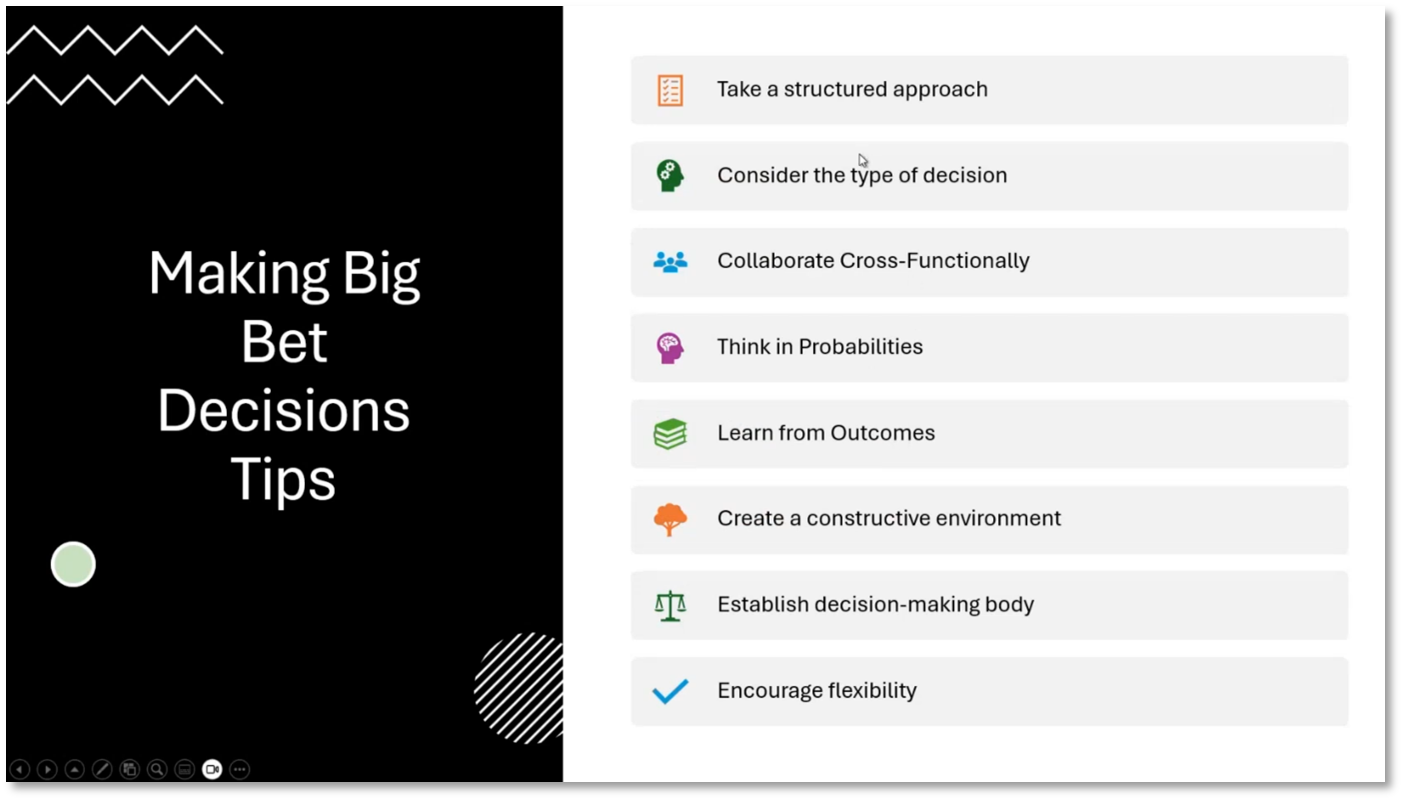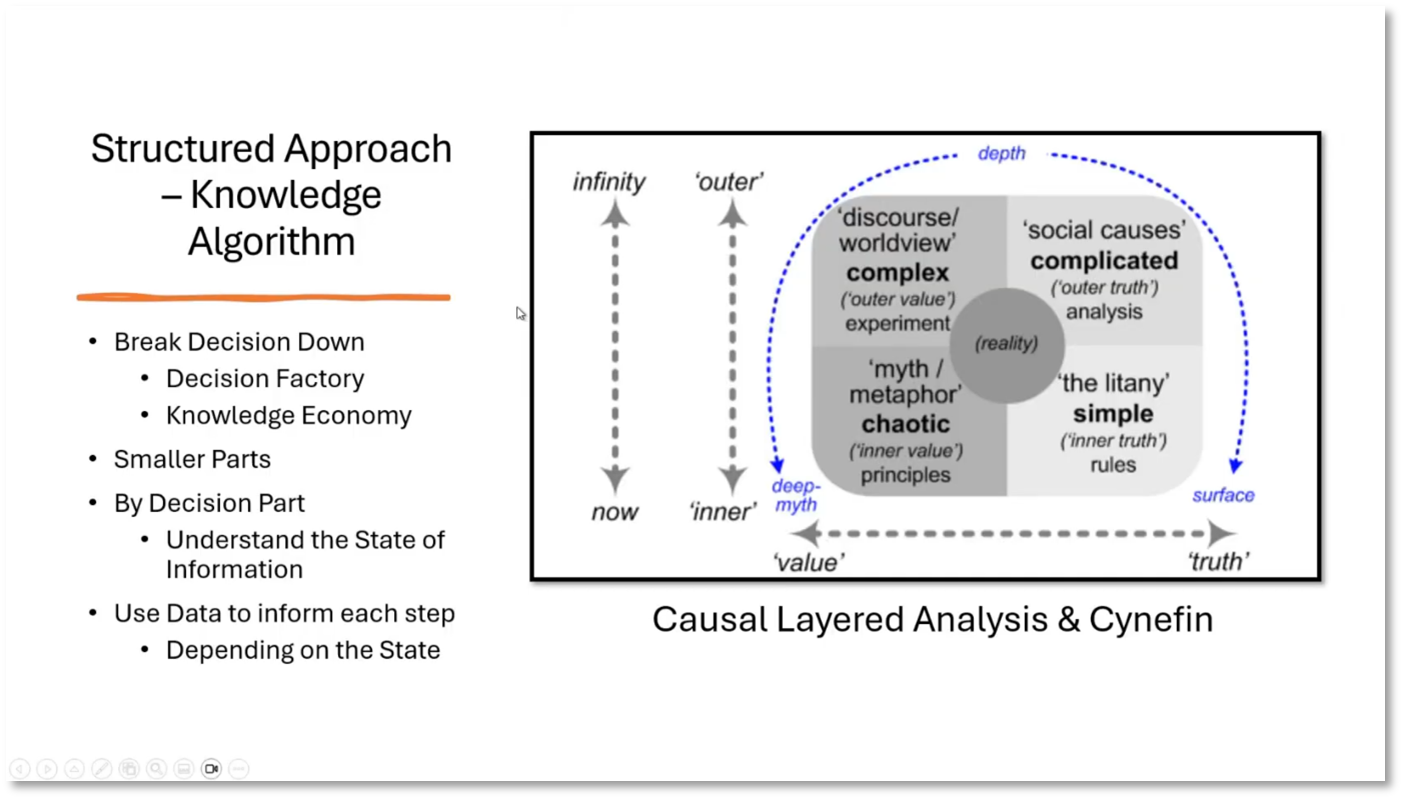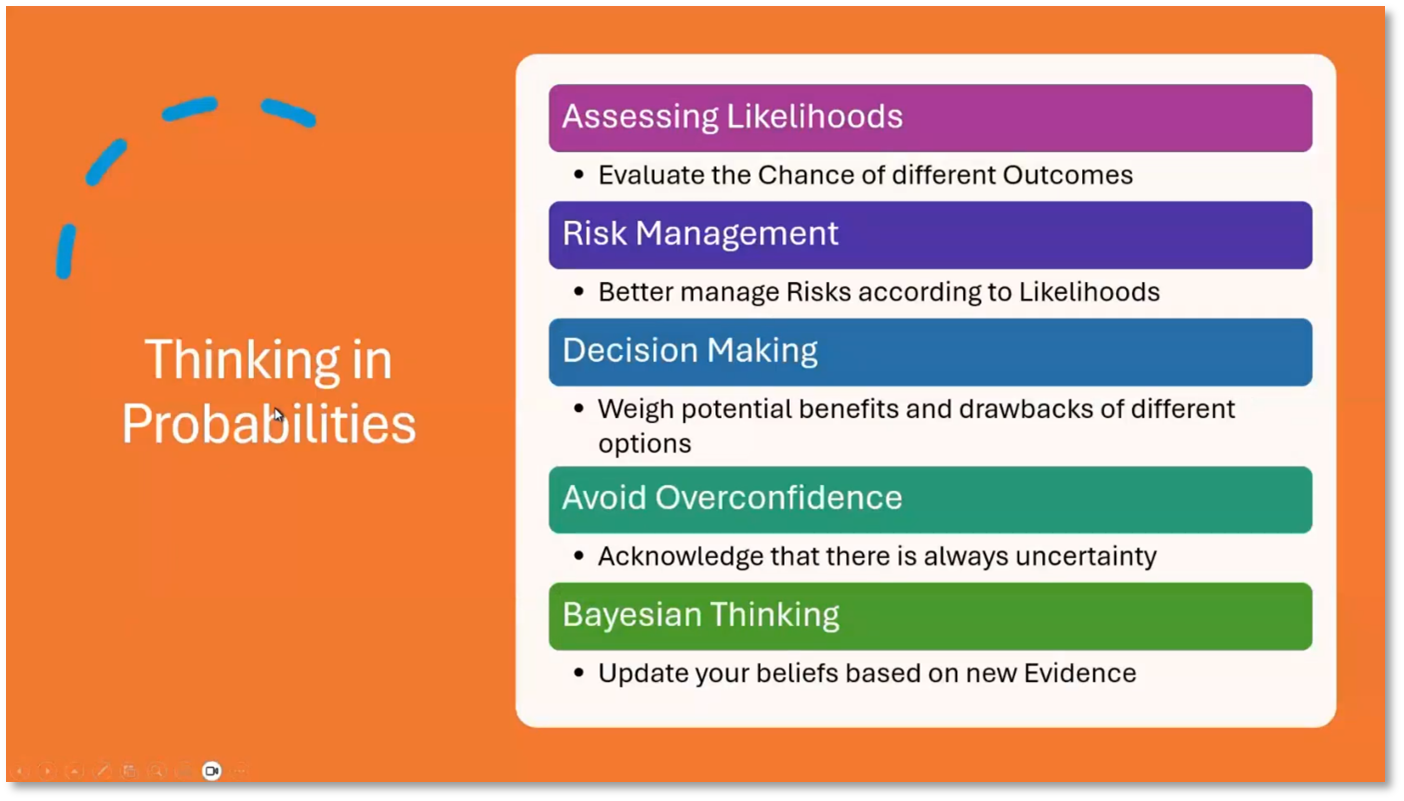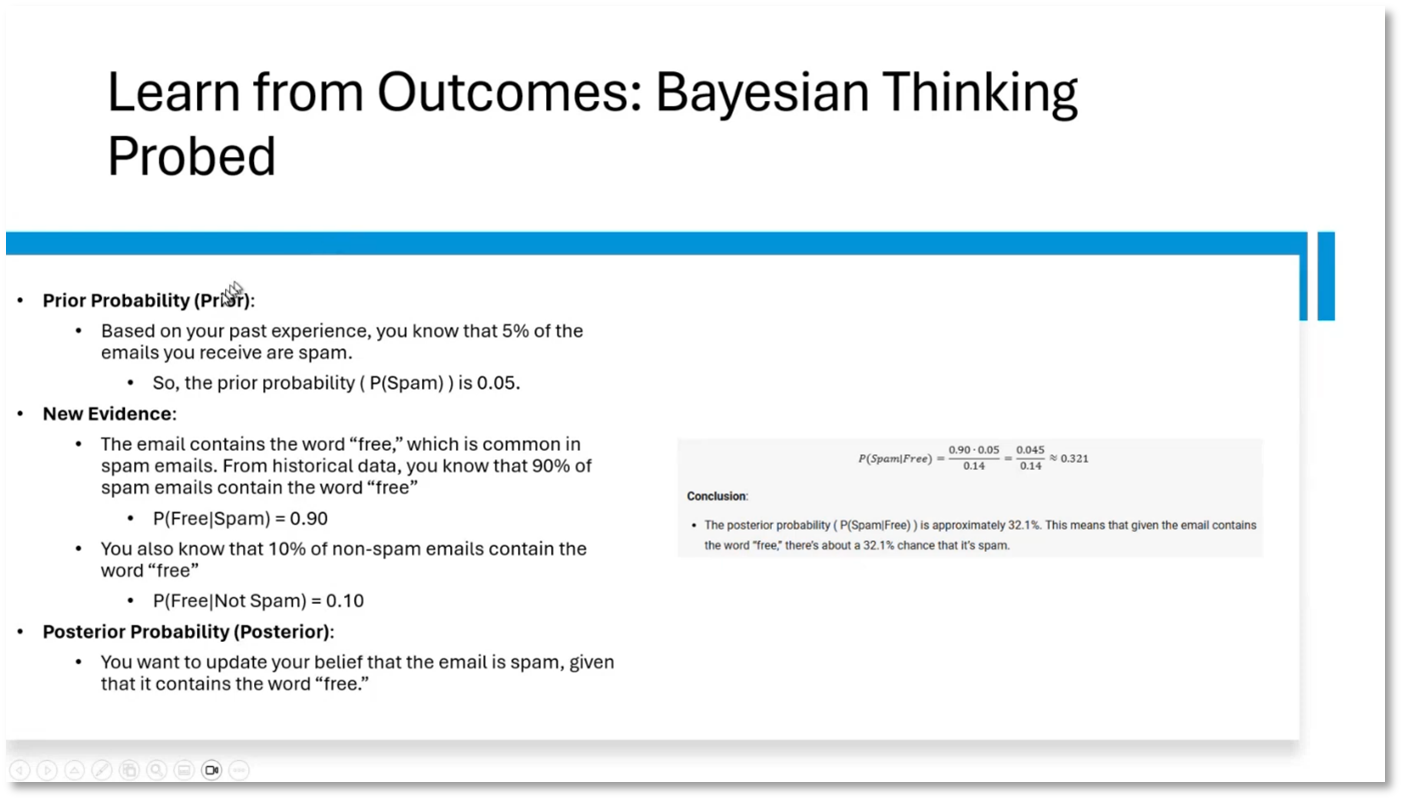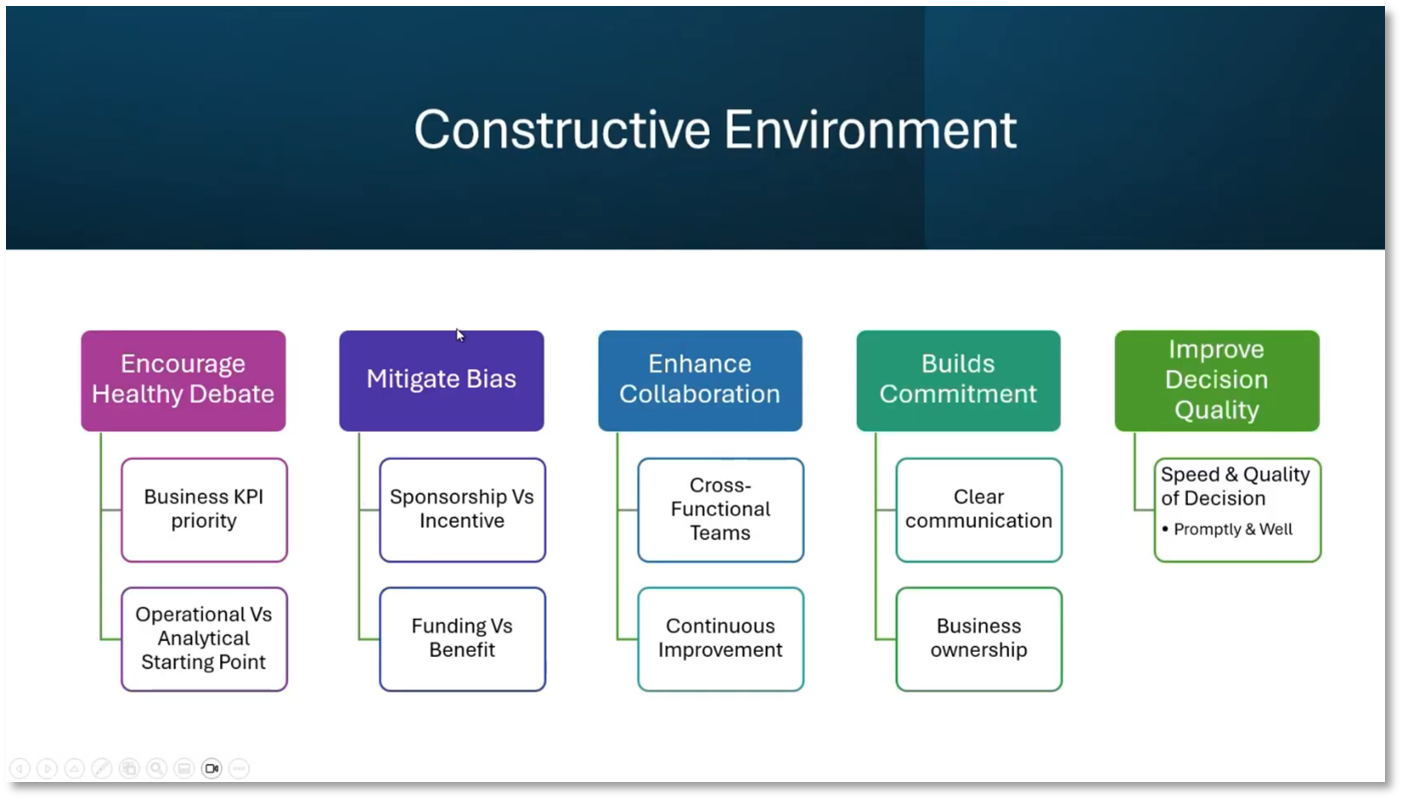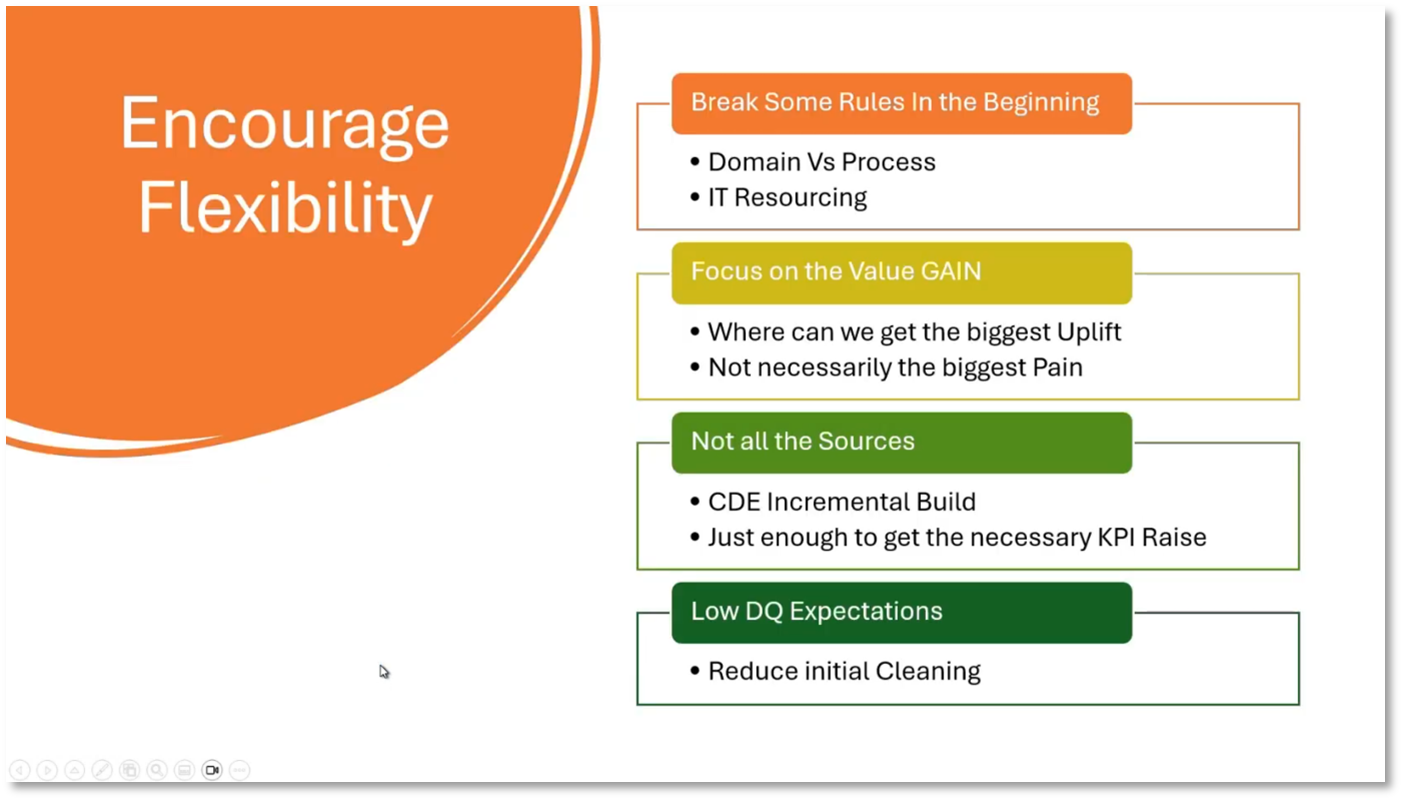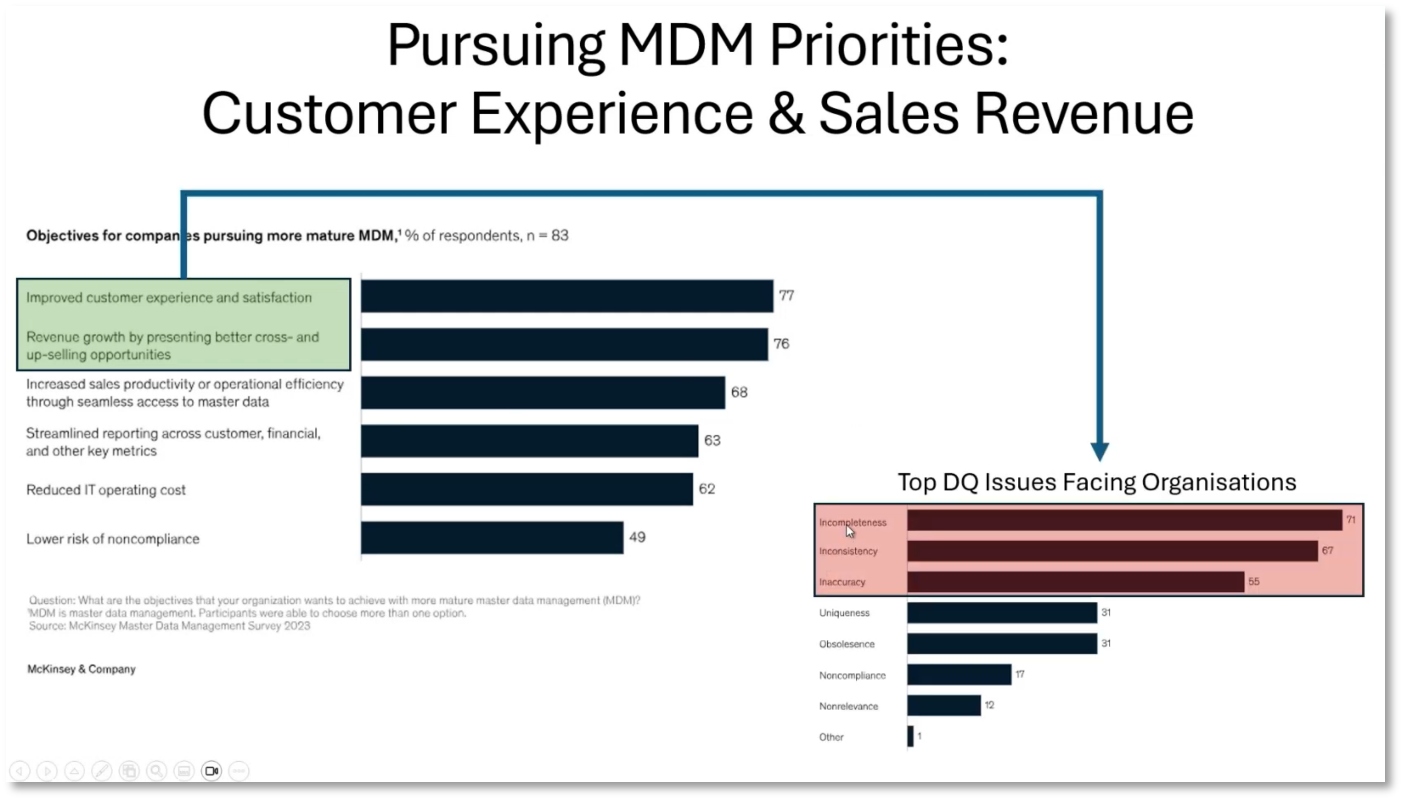Reference & Master Data Management for Data-Driven Executives
Executive Summary
This webinar provides an overview of the key topics related to Data Management and business operations. Howard Diesel covers the importance of Reference and Master Data Management in different industries, as well as the roles and responsibilities in Data Management. Decision-making processes, risk management, and the strategic importance of Data Management are also highlighted. ‘Reference and Master Data Management for Data-Driven Executives’ emphasises the significance of understanding ROI, effective decision-making, and the potential use of IT resources in business development. Furthermore, it touches upon customer engagement, value-driven Data Management, and the role of generative AI in Master Data Management and customer interaction.
Webinar Details:
Title: Reference & Master Data Management for Data-Driven Executives
Date: 03 October 2024
Presenter: Howard Diesel
Meetup Group: Data Executives
Write-up Author: Howard Diesel
Contents
Executive Summary
Webinar Details
Preparing for the CDMP Metadata Specialist Training
Understanding the Roles and Responsibilities in Reference and Master Data Management Implementation
Importance of Reference and Master Data Management in Different Industries
Roles and Responsibilities in Data Management
Understanding Decision-Making Process and Responsibilities in Business Operations
Decision-Making and Role Roles in Data Management
Role of Data Executives in Cost Management and Value Propositions
Business Challenges in a Construction Industry
Importance of Value-Decoding and Customer Data in Business Strategy
Risk Management and Data Presentation in Organizations
The Importance of Strategic Decision-Making in Data Management
Business Priorities and Critical Data Components
Risk Management and Information Retrieval in Big Bets
Implementing Effective Marketing Priorities
Data and Risk Management in Business
Navigating Customer Engagement in Business: A Case Study of Heineken in America
Business Challenges and Opportunities in Data Management and Sales Strategy
Understanding and Calculating ROI in Business
Effective Decision Making
Understanding and Utilizing Various Approaches in Decision-Making
Building a Constructive Environment and Managing Risk in Business
Potential Use of IT Resources in Business Development
Data Quality and Master Data Implementation in Business Decision-Making
The Role of Generative AI in Master Data Management and Customer Interaction
DAMA Framework and the Importance of the 'Why' in Business Processes
Value-Driven Data Management in IT and Data Functions
Preparing for the CDMP Metadata Specialist Training
Howard Diesel opens the webinar and introduces Drew Kennedy, who will conduct a metadata session as part of the CDMP metadata specialist training. ‘Reference and Master Data Management’ has served as a preview of the course content, with around 300 slides to be covered in a three-day course. Howard's goal is to prepare participants for the CDMP specialist exam while also providing a comprehensive understanding of various related areas.
Understanding the Roles and Responsibilities in Reference and Master Data Management Implementation
The Reference and Master Data Management is essential for establishing and managing functions within an organisation. The Data Manager is responsible for assessing the organisation's readiness to implement Reference and Master Data, considering factors such as collaboration, business benefits, and organisational skills. They must also establish programs, principles, policies, procedures, and technology, Reference architecture, ensuring that the architecture aligns with business requirements and guides technology purchases.
Figure 1 Webinar Series Overview
Importance of Reference and Master Data Management in Different Industries
There are Reference and Master Data technologies in place to handle the complexities of managing product Master Data in retail and service organisations. Howard shares on the role of Data Stewards and the challenges of managing the Reference Data, Master Data, transactional data, and Internet of Things data. These challenges highlight the differences between Master Data Stewardship and Reference Data Stewardship, emphasising the need for standard operating procedures and careful consideration of updates to Reference Data.
Roles and Responsibilities in Data Management
The Data Management framework consists of four key roles: Data Citizens as Data Stewards, Data Professionals, and Data Executives. Data Professionals are responsible for tasks such as building data models, understanding data integration and interoperability, and advising on incremental implementation. In contrast, Data Executives focus on making big decisions regarding establishing data capabilities and ensuring value delivery to the organisation. The Data Executive's role involves building a business case, justifying Return On Investment (ROI), and aligning strategies with business objectives. This hierarchy ensures that each role has distinct responsibilities and contributes to the overall Data Management strategy.
Understanding Decision-Making Process and Responsibilities in Business Operations
Before making significant decisions, it's important to consider decision mandates. The practice manager is responsible for allocating decision mandates, broadly categorized as Big Bet Decisions with major business impact, narrow ad hoc decisions, cross-cutting decisions spanning organisational boundaries, and delegated decisions involving Data Stewards. McKinsey's ABCDS framework is useful for categorising decision-making. Howard notes that he likes to create a Responsible, Accountable, Consulted and Informed (RACI) diagram with critical stakeholders to help clarify responsibilities. In the context of Data Management, various stakeholders, such as data owners and the Data Governance council, have specific accountabilities related to Master Data domains, data initiatives, and day-to-day Data Management. This breakdown can be effectively organised in a spreadsheet for clarity and reference.
Figure 2 Decision Mandates
Figure 3 ABCDs of Categorising Decisions
Figure 4 Reference and Master Data Critical Stakeholders and RACI
Decision-Making and Role Roles in Data Management
The decision-making process in the realm of Data Governance involves various roles, such as Data Executives, Data Managers, Data Professionals, and the team. The executive is responsible for recommending the implementation of Reference and Master Data, requiring a Data Governance framework and establishing Data Management practices, which necessitates a business case justification. On the other hand, the Data Manager recommends governance frameworks, data domains, and emergency updates, particularly in the event of compliance issues. Data Professionals are primarily involved in the implementation process, while Data Stewards also play a significant role in this. Each role has its distinct responsibilities within the Data Governance framework.
Figure 5 Reference and Master Data Decisions
Figure 6 Reference and Master Data Executive Decisions
Figure 7 Reference and Master Data Manager Decisions
Figure 8 Reference and Master Data Professional Decisions
Role of Data Executives in Cost Management and Value Propositions
Howard opens up about his experience as a Data Executive presenting to a board. The focus shifted from cost discussions to emphasising the value of implementing Reference and Master Data Management in the organisation. Howard emphasises the importance of demonstrating the value to justify costs, as he notes that when value outweighs costs, the board is more likely to approve the initiative. His experience underscored this when his proposal for Reference and Master Data Management was rejected due to cost concerns. At the same time, an AI innovation hub was approved based on its perceived value. Thus, emphasising value over cost in decision-making processes is effective in gaining approval for a proposal, particularly in cost-cutting environments.
Justifying Reference and Master Data Management can be challenging, and the lack of support in the business regarding costs can make it more so. Howard advises finding a functional leader for support and emphasises the importance of sharing and understanding the value delivered. He also highlights the importance of addressing high risks and establishing governance when implementing Master Data systems. Additionally, Howard emphasises the need to demonstrate the higher rewards and value of such implementations, especially when consolidating multiple ERP systems.
Figure 9 Data Executive and Big Bet Decision – Reference and Master Data Capability
Figure 10 Getting your Reference and Master Data Big Bet Decision Accepted
Business Challenges in a Construction Industry
An attendee mentions the challenges a cement organisation faces in consolidating and standardising its data. This led to a lack of data accuracy and, in some cases, duplicate records and inconsistencies across datasets. As a result, there were significant costs and operational challenges. The example highlights the importance of recognising the business opportunity, justifying the investment, and describing the future impact and challenges associated with data consolidation and standardisation.
Figure 11 Big Bet Decision Elements
Importance of Value-Decoding and Customer Data in Business Strategy
Articulating high rewards and using a monetary figure are helpful practices to quantify value. The concept of "360," referring to all the data related to a product or customer, is suggested as a means to determine the potential impact on customer behaviour and demographics. Howard also suggests that adding critical data elements could drive cross-selling and upselling, leading to increased KPIs and potentially impacting their bonus. This requires demonstrating the business impact of data initiatives and understanding the implications for the functional leader's objectives and performance incentives.
Risk Management and Data Presentation in Organizations
When presenting high-risk, high-reward proposals, it's crucial to consider the audience's risk tolerance level. Collaborating with functional leaders and demonstrating the necessity of data support can help align interests and facilitate co-presentations. For instance, marketing teams heavily rely on customer data platforms despite concerns about data quality. To effectively address these challenges, it's essential to honestly assess risks and develop mitigation strategies. Conducting a thorough risk assessment is also important in this context.
The Importance of Strategic Decision-Making in Data Management
An attendee shares on their experience with implementing changes in Reference Data within their organisation, which resulted in unforeseen risks and the need for a rollback. Clearly outlining the differential between risk and reward when proposing projects will help to convince executives. Howard highlights the significant risks associated with operational Master Data compared to analytical Master Data, citing examples of disruptions in business processes due to Master Data errors. Thus, he advises against initiating a Reference and Master Data program with operational Master Data and recommends first prioritising value drivers and benefits from the analytical side. Additionally, Howard suggests having an incremental plan and state reconstruction to manage consequences and avoid surprises when making changes to critical data elements and business processes.
Business Priorities and Critical Data Components
To achieve high rewards, it's crucial to shift focus from discussing business outcomes to identifying valid outcomes that impact key performance indicators (KPIs). Rather than attempting to address every KPI related to customer cross-selling, it's recommended to hyper-focus on one or two KPIs, or even just one, and streamline the critical data elements and sources required for improvement. By emphasising specific outcomes that affect KPIs and collaborating with business functional leaders, such as improving cross-sells, reducing inventory costs, and lowering the risk of fraud, businesses can drive significant improvements without spreading resources too thin.
Figure 12 High Reward Decision Making
Figure 13 High Reward Decision Making Continued
Risk Management and Information Retrieval in Big Bets
When making significant decisions, it's crucial to have a comprehensive understanding of the available information. Big bets should be carefully assessed and quantified, with a focus on controlled and empowered areas. Transitioning from a probed environment to an analysed one requires gathering more data and evaluating its trustworthiness. It's essential to conduct a cost-benefit analysis using reliable sources and ensure that the data is fit for the key performance indicators (KPIs). Maintaining a laser focus on the KPIs is vital, and the aim should be to move from unknown information to known information to make clear, informed decisions.
Figure 14 High Risk and Decision Making
Figure 15 High Risk and Decision Making Continued
Figure 16 High Risk and Decision Making Continued
Implementing Effective Marketing Priorities
After reviewing McKinsey and Gartner, Howard mentions identifying current priorities for Master Data Management (MDM). The typical current priorities include customer experience and satisfaction marketing, segmentation, mapping the right products to customers, and improving revenue growth by cross-selling. The top data quality (DQ) issues facing businesses in these areas are incompleteness and inaccuracy, which hinder efforts to validate customer experience and satisfaction. Addressing these issues is crucial for achieving improved customer experience and revenue growth. Probing and analysing the data to understand the situation and gather evidence to support MDM priorities is essential.
Figure 17 Pursuing Master Data Management Priorities: Customer Experience and Sales Revenue with Top DQ Issues
Data and Risk Management in Business
Justifying business decisions with a minimal number of critical data elements to maximise impact is key. Rather than aiming for a comprehensive 360-degree view, the emphasis is on identifying the essential data elements that will drive business benefits. It's important to avoid getting bogged down in extensive data cleaning and analysis, especially when dealing with large customer datasets. The advice is to prioritise essential data cleanup and avoid wasting effort on obsolete data, ultimately focusing on reducing risk and demonstrating value quickly.
Figure 18 Future Impact Future Target
Navigating Customer Engagement in Business: A Case Study of Heineken in America
Howard notes that Heineken faced challenges in the American market due to advertising restrictions and limitations on collecting first-party data. To overcome these obstacles, the company focused on engaging customers through sponsored events rather than directly advertising its products. They shifted from using third-party data to relying on Master Data to gain customer insights and create new experiences. By taking this approach, Heineken was able to tackle the issues and unify customer data in a customer Master Data domain.
Figure 19 Customer Journeys
Business Challenges and Opportunities in Data Management and Sales Strategy
An example of a company facing challenges due to various legacy systems and fragmented customer data records is displayed. Howard notes that these challenges lead to inefficiencies in sales processes, particularly in billing. By streamlining operations, they aimed to reduce the time from opportunity to payment, which would significantly improve cash flows. The projected costs for the improvement initiative included a 10% increase in personnel, 12% for software, 16% for hardware, and 61% for consulting. At the same time, the anticipated benefits encompassed reduced data quality processes, improved Data Management, and enhanced integration, resulting in a total benefit of 77.6 million and costs of 4.8 million.
Figure 20 Business Challenges and Opportunities
Figure 21 Resource Investment and ROI
Understanding and Calculating ROI in Business
The payback period is critical to the return on investment (ROI) analysis. In this case, the payback period was 2.4 years. It's crucial because initially, there is a significant negative cash flow, which only starts to turn positive in years two and three. These early years are considered troubled periods due to the high implementation costs and concerns about working capital. However, the focus is on recovering the investment quickly after the initial spending, leading to a positive cash flow. This analysis emphasises the importance of monitoring the ROI at this level and being mindful of the payback period.
Figure 22 Resource Investment and ROI Continued
Effective Decision Making
The process of making Big Bet Decisions involves breaking them down into smaller parts and analysing the information to understand the state of the data. The Cynefin framework is useful for understanding the complexity of decisions, ranging from simple cause-and-effect scenarios to complex and chaotic situations. It emphasises the use of analytical techniques to determine the appropriate approach for each decision. In chaotic situations, taking immediate action and adjusting based on feedback is crucial, while building hypotheses and conducting experiments are necessary in complex scenarios. The overall goal is to understand the state of information for each decision part and adjust the approach accordingly.
Figure 23 Tips for Making Big Bet Decisions
Figure 24 Structured Approach – Knowledge Algorithm
Figure 25 Type of Decision using the Cynefin Framework
Understanding and Utilizing Various Approaches in Decision-Making
Howard emphasises the importance of cause and effect, decision-making, and thinking in probabilities. Using different experts to find answers and make decisions based on potential benefits is suggested. An example of planning an outdoor event is used to illustrate cost analysis and weighing probabilities. Adding data and known facts based on evidence is highlighted, along with an approach to dealing with spam emails using Bayesian thinking and probabilities to reduce uncertainties.
Figure 26 Thinking in Probabilities
Figure 27 Outdoor Event Planning Scenario
Figure 28 Learning from Outcomes: Bayesian Thinking Probed
Building a Constructive Environment and Managing Risk in Business
The key points for creating a constructive and risk-aware environment are centred around using KPI priorities to shift attitudes towards risk, actively mitigating risks, and fostering open communication. It's crucial to gain support from influential figures such as the CFO or CEO and to identify business function leaders with a vested interest in the initiative. Collaboration amongst cross-functional teams and a focus on continuous improvement are essential, as well as maintaining clear communication, business ownership, and improving decision quality. Encouraging flexibility and focusing on improving decision-making processes rather than fixating on specific domains.
Figure 29 Constructive Environment
Figure 30 Encourage Flexibility
Potential Use of IT Resources in Business Development
When starting a project, consider using IT resources alongside business personnel. Focus on gaining value rather than just addressing pain points, prioritise incremental progress, and be flexible with data quality expectations when needed. Always remember the ultimate purpose and make decisions based on the minimum level of data quality required to achieve functional benefits.
Data Quality and Master Data Implementation in Business Decision-Making
Howard emphasises the importance of Master Data Management in decision-making, highlighting the need for accurate and reliable data for customer data platforms. He also points out the difference between operational Master Data in Enterprise Resource Planning (ERP) systems and analytical Master Data in a consolidated tool, underscoring the value of having a complete view of customer information for driving analytics and improving customer experience. Additionally, the conversation addressed data quality challenges and the necessity of aligning data elements with data quality dimensions to enhance customer targeting and product servicing.
Figure 31 MDM Priorities: Customer Experience and Sales Revenue
The Role of Generative AI in Master Data Management and Customer Interaction
This scenario illustrates the use of generative AI in Data Management within a call centre context. The AI collected and analysed customer interaction data, enabling agents to understand customer frustration better and respond accordingly. It highlights the importance of having accurate Master Data for the AI to comprehend the interaction history and provide valuable insights to agents. This led to improved customer interactions and addressed where the quickest benefit lies in engaging with a customer: in interaction or system fixes.
Figure 32 The Role of Generative AI in master Data Management
Figure 33 The Role of Generative AI in master Data Management
DAMA Framework and the Importance of the 'Why' in Business Processes
An attendee expresses enthusiasm for the John Zachman framework for Enterprise Architecture, emphasising the importance of addressing the "why" behind initiatives such as Master Data Management (MDM) and Reference Data Management (RDM). They highlight the significance of considering business drivers and the interconnectedness of various domains, such as customer, product, and location, in achieving the desired outcomes. Howard adds to this by emphasising the need to shift focus from the "what" to the "why" to drive meaningful results. He then stresses that understanding the motivation behind business processes is critical for success.
Value-Driven Data Management in IT and Data Functions
Another attendee mentions the common mindset in IT of "build it and they will come," and how this approach creates challenges. Howard agrees and mentions the "value driven Data Management," which involves identifying use cases that produce value, conducting feasibility studies, and ensuring technical capability before delivering results through sprints. Thus, aligning with business leaders and focusing on delivering business functionality and decisions. Howard advocates for resequencing the Data Management approach to prioritise value initiatives within the data strategy. This shift, he notes, aims to emphasise teamwork and delivering value rather than compartmentalising functions like data quality, governance, and BI.
If you want to receive the recording, kindly contact Debbie (social@modelwaresystems.com)
Don’t forget to join our exciting LinkedIn and Meetup data communities not to miss out!


